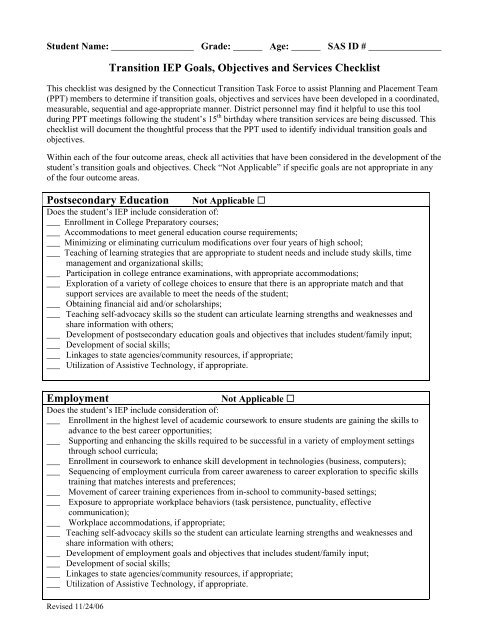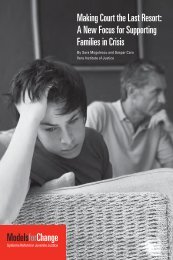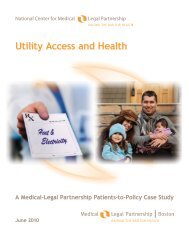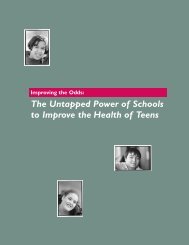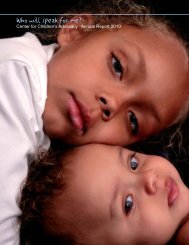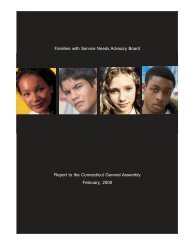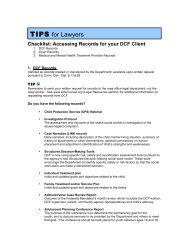TRANSITION IEP GOALS, OBJECTIVES AND SERVICES CHECKLIST
TRANSITION IEP GOALS, OBJECTIVES AND SERVICES CHECKLIST
TRANSITION IEP GOALS, OBJECTIVES AND SERVICES CHECKLIST
- No tags were found...
Create successful ePaper yourself
Turn your PDF publications into a flip-book with our unique Google optimized e-Paper software.
Student Name: _________________ Grade: ______ Age: ______ SAS ID # _______________Transition <strong>IEP</strong> Goals, Objectives and Services ChecklistThis checklist was designed by the Connecticut Transition Task Force to assist Planning and Placement Team(PPT) members to determine if transition goals, objectives and services have been developed in a coordinated,measurable, sequential and age-appropriate manner. District personnel may find it helpful to use this toolduring PPT meetings following the student’s 15 th birthday where transition services are being discussed. Thischecklist will document the thoughtful process that the PPT used to identify individual transition goals andobjectives.Within each of the four outcome areas, check all activities that have been considered in the development of thestudent’s transition goals and objectives. Check “Not Applicable” if specific goals are not appropriate in anyof the four outcome areas.Postsecondary Education Not Applicable Does the student’s <strong>IEP</strong> include consideration of:___ Enrollment in College Preparatory courses;___ Accommodations to meet general education course requirements;___ Minimizing or eliminating curriculum modifications over four years of high school;___ Teaching of learning strategies that are appropriate to student needs and include study skills, timemanagement and organizational skills;___ Participation in college entrance examinations, with appropriate accommodations;___ Exploration of a variety of college choices to ensure that there is an appropriate match and thatsupport services are available to meet the needs of the student;___ Obtaining financial aid and/or scholarships;___ Teaching self-advocacy skills so the student can articulate learning strengths and weaknesses andshare information with others;___ Development of postsecondary education goals and objectives that includes student/family input;___ Development of social skills;___ Linkages to state agencies/community resources, if appropriate;___ Utilization of Assistive Technology, if appropriate.EmploymentNot Applicable Does the student’s <strong>IEP</strong> include consideration of:___ Enrollment in the highest level of academic coursework to ensure students are gaining the skills toadvance to the best career opportunities;___ Supporting and enhancing the skills required to be successful in a variety of employment settingsthrough school curricula;___ Enrollment in coursework to enhance skill development in technologies (business, computers);___ Sequencing of employment curricula from career awareness to career exploration to specific skillstraining that matches interests and preferences;___ Movement of career training experiences from in-school to community-based settings;___ Exposure to appropriate workplace behaviors (task persistence, punctuality, effectivecommunication);___ Workplace accommodations, if appropriate;___ Teaching self-advocacy skills so the student can articulate learning strengths and weaknesses andshare information with others;___ Development of employment goals and objectives that includes student/family input;___ Development of social skills;___ Linkages to state agencies/community resources, if appropriate;___ Utilization of Assistive Technology, if appropriate.Revised 11/24/06
Independent LivingNot Applicable Does the student’s <strong>IEP</strong> include consideration of:___ Enrollment in curricula that addresses:___ Personal/legal advocacy;___ Personal Finance Management;___ Household selection and management;___ Daily Living skills;___ Family Planning/Sex Education;___ Nutrition;___ Consumer Skills;___ Personal and health insurance;___ Managing individual health care and medical needs in all environments;___ Providing skills training in a community-based setting, if appropriate;___ Participation of all appropriate pupil personnel and general education staff who could support thestudent in independent living skills development;___ Teaching self-advocacy skills so the student can articulate learning strengths and weaknesses andshare information with others;___ Development of independent living goals and objectives that includes student/family input;___ Development of social skills;___ Linkages to state agencies/community resources, if appropriate;___ Utilization of Assistive Technology, if appropriate.Community Participation Not Applicable Does the student’s <strong>IEP</strong> include consideration of:___ Participation in extracurricular activities (clubs, sports);___ Use of transportation options: independent, public, specialized;___ Need for travel training;___ Participation in community recreation/leisure activities;___ Strengthening of friendships/relationships;___ Voting and citizenship;___ Inclusion in social groups/clubs;___ Volunteering;___ Providing skills training in a community-based setting, if appropriate;___ Teaching self-advocacy skills so the student can articulate learning strengths and weaknesses andshare information with others;___ Development of community participation goals and objectives that includes student/family input;___ Development of social skills;___ Linkages to state agencies/community resources, if appropriate;___ Utilization of Assistive Technology, if appropriate.Revised 11/24/06


